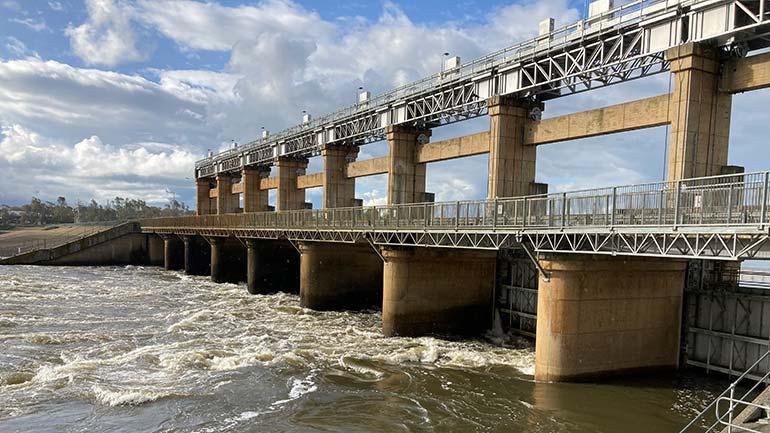All the locks and weirs along the Murray River were removed or opened during the 2022–23 floods to make way for high flows and debris coming down the river.
This was the first time in decades that the river was free flowing from the Yarrawonga weir all the way to the Southern Ocean.
Now that flood waters are receding, it’s time to put the locks and weirs back to work.
So what is a weir and why do we have them?
If you live near the river or travel by boat, you would probably be familiar with these dam-like structures. They hold back the flow of water so it can be more easily managed for irrigation, domestic supply and industrial use – they provide many benefits to people who rely on the river.
A weir creates a consistent pool of water in the river upstream of the weir. This means it is often a recreational hub and the basis for tourism for many communities.
All the weirs on the Murray, except the one at Yarrawonga, have a lock attached. Locks allow boats to pass through the section of river that has been blocked by the weir. Using heavy automated doors in the river, they create a chamber for the vessel to be lowered to the river level downstream of the weir raised to the upstream height for those travelling in the other direction.
Fish like to migrate throughout the river system so they also need a way to get around the weirs that block their path. In recent years this movement has been enabled by installing specialised fish ladders of various designs to help fish move from the downstream side of a weir to the upstream side. Find out how fish use ladders.
A bit of history
Before weirs were built, the natural fluctuations in the flow of the Murray River meant water supply was unpredictable, making it hard for growing towns and the traders who used the river to transport their cargo.
In 1914, the Commonwealth, Victorian, New South Wales and South Australian governments agreed that building locks and weirs was the best way to provide reliable water flow to support transport passage.
The weir and lock 1 at Blanchetown in South Australia were the first to be completed in 1922.

Original plans included a series of 26 locks and weirs to enable the paddle steamer trade to navigate all the way from Goolwa to Echuca, but as rail and road become the preferred mode of transport it got to the point where there wasn’t the same need for locks and weirs, and the final few weren’t built.
This is why we have lock 1 to lock 11 in Mildura and then a gap until lock 15 at Euston, and then lock 26 in Torrumbarry.
All the locks and weirs are managed on behalf of the Murray–Darling Basin Authority by the states through their state constructing authorities.
Not all locks and weirs are the same
There are 14 weirs on the Murray including the large one at Yarrawonga, and 4 types of weir construction. Weirs 1 to 10 and weir 15 are made of concrete piers that support removable concrete panels known as stoplogs.

When the Torrumbarry weir at lock 26 was built in 1924, it was the same structure as the Mildura weir but was upgraded in 1996 with large radial ‘chamber’ gates instead of concrete stoplogs.

Completed in 1927, Mildura weir is made of 24 steel trestles running on rails across the bed of the river, each weighing approximately 11 tonnes and held in place with wooden boards. As you can imagine, when the trestles need to be removed they are moved individually with an electrically driven winch. Its nearby partner, lock 11, is a concrete chamber with four steel lock gates. To fill the lock, four butterfly valves are opened to allow upstream water in.

And finally, Yarrawonga weir, completed in 1939, is an earthen bank and concrete weir with large vertical lift gates and the only weir that does not have a lock attached.
Reinstating the locks and weirs
Given the complexity and scale of these structures reinstating the locks and weirs after a flood requires more than just a push of a button. It’s a task involving hard work and expertise to ensure it’s done safely and at the right time for that section of river.
As river levels fall and flood waters recede, lockmasters and river operators safely inspect the structures and repair any damage that might have occurred during the floods. Work can then start on reinstalling the weirs and refilling the weir pools to return the river to a fully regulated state.
As you can see, locks and weirs play an important role in maintaining river levels and managing flows. They’re also key to supporting thriving communities, industries and tourism.
Some might say weirs are the quiet achievers of the river system while doing a lot of the heavy lifting.
Contact the MDBA media office at media@mdba.gov.au or 02 6279 0141
Contact the CEWH media office at media@environment.gov.au or 02 6275 9880
Contact the NSW media office at media@dpie.nsw.gov.au or 0499 699 460